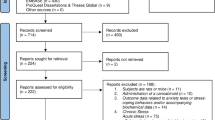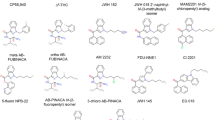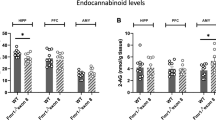Abstract
Although it is well established that cannabinoid drugs can influence cognitive performance, the findings—describing both enhancing and impairing effects—have been ambiguous. Here, we investigated the effects of posttraining systemic administration of the synthetic cannabinoid agonist WIN55,212-2 (0.1, 0.3, or 1.0 mg/kg) on short- and long-term retention of object recognition memory under two conditions that differed in their training-associated arousal level. In male Sprague-Dawley rats that were not previously habituated to the experimental context, WIN55,212-2 administered immediately after a 3-min training trial, biphasically impaired retention performance at a 1-h interval. In contrast, WIN55,212-2 enhanced 1-h retention of rats that had received extensive prior habituation to the experimental context. Interestingly, immediate posttraining administration of WIN55,212-2 to non-habituated rats, in doses that impaired 1-h retention, enhanced object recognition performance at a 24-h interval. Posttraining WIN55,212-2 administration to habituated rats did not significantly affect 24-h retention. In light of intimate interactions between cannabinoids and the hypothalamic–pituitary–adrenal axis, we further investigated whether cannabinoid administration might differently influence training-induced glucocorticoid activity in rats in these two habituation conditions. WIN55,212-2 administered after object recognition training elevated plasma corticosterone levels in non-habituated rats whereas it decreased corticosterone levels in habituated rats. Most importantly, following pretreatment with the corticosterone-synthesis inhibitor metyrapone, WIN55,212-2 effects on 1- and 24-h retention of non-habituated rats became similar to those seen in the low-aroused habituated animals, indicating that cannabinoid-induced regulation of adrenocortical activity contributes to the environmentally sensitive effects of systemically administered cannabinoids on short- and long-term retention of object recognition memory.
Similar content being viewed by others
Log in or create a free account to read this content
Gain free access to this article, as well as selected content from this journal and more on nature.com
or
References
Armario A (2010). Activation of the hypothalamic-pituitary-adrenal axis by addictive drugs: different pathways, common outcome. Trends Pharmacol Sci 31: 318–325.
Atsak P, Hauer D, Campolongo P, Schelling G, McGaugh JL, Roozendaal B (2012a). Glucocorticoids interact with the hippocampal endocannabinoid system in impairing retrieval of contextual fear memory. Proc Natl Acad Sci USA 109: 3504–3509.
Atsak P, Roozendaal B, Campolongo P (2012b). Role of the endocannabinoid system in regulating glucocorticoid effects on memory for emotional experiences. Neuroscience 204: 104–116.
Baek J, Zheng Y, Darlington CL, Smith PF (2009). The CB1 receptor agonist, WIN 55,212-2, dose-dependently disrupts object recognition memory in adult rats. Neurosci Lett 464: 71–73.
Barna I, Zelena D, Arszovszki AC, Ledent C (2004). The role of endogenous cannabinoids in the hypothalamo-pituitary-adrenal axis regulation: in vivo and in vitro studies in CB1 receptor knockout mice. Life Sci 75: 2959–2970.
Barros DM, Carlis V, Maidana M, Silva ES, Baisch AL, Ramirez MR et al (2004). Interactions between anandamide-induced anterograde amnesia and post-training memory modulatory systems. Brain Res 1016: 66–71.
Cahill L, McGaugh JL, Weinberger NM (2001). The neurobiology of learning and memory: some reminders to remember. Trends Neurosci 24: 578–581.
Campolongo P, Ratano P, Manduca A, Scattoni ML, Palmery M, Trezza V et al (2012). The endocannabinoid transport inhibitor AM404 differentially modulates recognition memory in rats depending on environmental aversiveness. Front Behav Neurosci 6: 11.
Campolongo P, Roozendaal B (2011). Stress and glucocorticoid effects on memory. In: Conrad CD, (ed) New Edition: Handbook of Stress: Neuropsychological Effects on the Brain. Wiley-Blackwell: Malden.
Campolongo P, Roozendaal B, Trezza V, Hauer D, Schelling G, McGaugh JL et al (2009). Endocannabinoids in the rat basolateral amygdala enhance memory consolidation and enable glucocorticoid modulation of memory. Proc Natl Acad Sci USA 106: 4888–4893.
Carlin AS, Bakker CB, Halpern L, Post RD (1972). Social facilitation of marijuana intoxication: impact of social set and pharmacological activity. J Abnorm Psychol 80: 132–140.
Chaperon F, Thiebot MH (1999). Behavioral effects of cannabinoid agents in animals. Crit Rev Neurobiol 13: 243–281.
Clarke JR, Rossato JI, Monteiro S, Bevilaqua LR, Izquierdo I, Cammarota M (2008). Posttraining activation of CB1 cannabinoid receptors in the CA1 region of the dorsal hippocampus impairs object recognition long-term memory. Neurobiol Learn Mem 90: 374–381.
Cota D, Steiner MA, Marsicano G, Cervino C, Herman JP, Grubler Y et al (2007). Requirement of cannabinoid receptor type 1 for the basal modulation of hypothalamic-pituitary-adrenal axis function. Endocrinology 148: 1574–1581.
De Oliveira AlvaresL, Genro BP, Diehl F, Quillfeldt JA (2008). Differential role of the hippocampal endocannabinoid system in the memory consolidation and retrieval mechanisms. Neurobiol Learn Mem 90: 1–9.
Deadwyler SA, Goonawardena AV, Hampson RE (2007). Short-term memory is modulated by the spontaneous release of endocannabinoids: evidence from hippocampal population codes. Behav Pharmacol 18: 571–580.
Di S, Malcher-Lopes R, Halmos KC, Tasker JG (2003). Nongenomic glucocorticoid inhibition via endocannabinoid release in the hypothalamus: a fast feedback mechanism. J Neurosci 23: 4850–4857.
Emmert MH, Herman JP (1999). Differential forebrain c-fos mRNA induction by ether inhalation and novelty: evidence for distinctive stress pathways. Brain Res 845: 60–67.
Feenstra MG, Botterblom MH, Mastenbroek S (2000). Dopamine and noradrenaline efflux in the prefrontal cortex in the light and dark period: effects of novelty and handling and comparison to the nucleus accumbens. Neuroscience 100: 741–748.
Fokos S, Panagis G (2010). Effects of delta9-tetrahydrocannabinol on reward and anxiety in rats exposed to chronic unpredictable stress. J Psychopharmacol 24: 767–777.
Ganon-Elazar E, Akirav I (2009). Cannabinoid receptor activation in the basolateral amygdala blocks the effects of stress on the conditioning and extinction of inhibitory avoidance. J Neurosci 29: 11078–11088.
Gobbi G, Bambico FR, Mangieri R, Bortolato M, Campolongo P, Solinas M et al (2005). Antidepressant-like activity and modulation of brain monoaminergic transmission by blockade of anandamide hydrolysis. Proc Natl Acad Sci USA 102: 18620–18625.
Green B, Kavanagh D, Young R (2003). Being stoned: a review of self-reported cannabis effects. Drug Alcohol Rev 22: 453–460.
Grota LJ, Bienen T, Felten DL (1997). Corticosterone responses of adult Lewis and Fischer rats. J Neuroimmunol 74: 95–101.
Haller J, Barna I, Barsvari B, Gyimesi Pelczer K, Yasar S, Panlilio LV et al (2009). Interactions between environmental aversiveness and the anxiolytic effects of enhanced cannabinoid signaling by FAAH inhibition in rats. Psychopharmacology (Berl) 204: 607–616.
Handa RJ, Nunley KM, Lorens SA, Louie JP, McGivern RF, Bollnow MR (1994). Androgen regulation of adrenocorticotropin and corticosterone secretion in the male rat following novelty and foot shock stressors. Physiol Behav 55: 117–124.
Hauer A, Fornari R, Atsak P, Campolongo P, Schelling G, Roozendaal R (2010). Memory consolidation via membrane glucocorticoid receptors that can be blocked by cannabinoid receptor antagonists. Eur Neuropsychopharmacol, (2010) 20: S283–S284.
Hill MN, Karatsoreos IN, Hillard CJ, McEwen BS (2010a). Rapid elevations in limbic endocannabinoid content by glucocorticoid hormones in vivo. Psychoneuroendocrinology 35: 1333–1338.
Hill MN, McEwen BS (2009). Endocannabinoids: The silent partner of glucocorticoids in the synapse. Proc Natl Acad Sci USA 106: 4579–4580.
Hill MN, Patel S, Campolongo P, Tasker JG, Wotjak CT, Bains JS (2010b). Functional interactions between stress and the endocannabinoid system: from synaptic signaling to behavioral output. J Neurosci 30: 14980–14986.
Hu W, Zhang M, Czeh B, Zhang W, Flugge G (2011). Chronic restraint stress impairs endocannabinoid mediated suppression of GABAergic signaling in the hippocampus of adult male rats. Brain Res Bull 85: 374–379.
Kathuria S, Gaetani S, Fegley D, Valino F, Duranti A, Tontini A et al (2003). Modulation of anxiety through blockade of anandamide hydrolysis. Nat Med 9: 76–81.
Kosiorek P, Hryniewicz A, Bialuk I, Zawadzka A, Winnicka MM (2003). Cannabinoids alter recognition memory in rats. Pol J Pharmacol 55: 903–910.
Marsicano G, Lafenetre P (2009). Roles of the endocannabinoid system in learning and memory. Curr Top Behav Neurosci 1: 201–230.
McGaugh JL (2000). Memory--a century of consolidation. Science 287: 248–251.
McGaugh JL, Roozendaal B (2002). Role of adrenal stress hormones in forming lasting memories in the brain. Curr Opin Neurobiol 12: 205–210.
McQuade R, Creton D, Stanford SC (1999). Effect of novel environmental stimuli on rat behaviour and central noradrenaline function measured by in vivo microdialysis. Psychopharmacology (Berl) 145: 393–400.
Moreira FA, Wotjak CT (2011). Cannabinoids and anxiety. Curr Top Behav Neurosci 2: 429–450.
Okuda S, Roozendaal B, McGaugh JL (2004). Glucocorticoid effects on object recognition memory require training-associated emotional arousal. Proc Natl Acad Sci USA 101: 853–858.
Pamplona FA, Bitencourt RM, Takahashi RN (2008). Short- and long-term effects of cannabinoids on the extinction of contextual fear memory in rats. Neurobiol Learn Mem 90: 290–293.
Patel S, Kingsley PJ, Mackie K, Marnett LJ, Winder DG (2009). Repeated homotypic stress elevates 2-arachidonoylglycerol levels and enhances short-term endocannabinoid signaling at inhibitory synapses in basolateral amygdala. Neuropsychopharmacology 34: 2699–2709.
Pattij T, Wiskerke J, Schoffelmeer AN (2008). Cannabinoid modulation of executive functions. Eur J Pharmacol 585: 458–463.
Piomelli D (2003). The molecular logic of endocannabinoid signalling. Nat Rev Neurosci 4: 873–884.
Quirarte GL, Roozendaal B, McGaugh JL (1997). Glucocorticoid enhancement of memory storage involves noradrenergic activation in the basolateral amygdala. Proc Natl Acad Sci USA 94: 14048–14053.
Robinson L, McKillop-Smith S, Ross NL, Pertwee RG, Hampson RE, Platt B et al (2008). Hippocampal endocannabinoids inhibit spatial learning and limit spatial memory in rats. Psychopharmacology (Berl) 198: 551–563.
Rodriguez de, Fonseca F, Del Arco I, Martin-Calderon JL, Gorriti MA, Navarro M (1998). Role of the endogenous cannabinoid system in the regulation of motor activity. Neurobiol Dis 5 (6 Pt B): 483–501.
Roozendaal B (2002). Stress and memory: opposing effects of glucocorticoids on memory consolidation and memory retrieval. Neurobiol Learn Mem 78: 578–595.
Roozendaal B, de Quervain DJ, Schelling G, McGaugh JL (2004). A systemically administered beta-adrenoceptor antagonist blocks corticosterone-induced impairment of contextual memory retrieval in rats. Neurobiol Learn Mem 81: 150–154.
Roozendaal B, Hui GK, Hui IR, Berlau DJ, McGaugh JL, Weinberger NM (2006a). Basolateral amygdala noradrenergic activity mediates corticosterone-induced enhancement of auditory fear conditioning. Neurobiol Learn Mem 86: 249–255.
Roozendaal B, McEwen BS, Chattarji S (2009). Stress, memory and the amygdala. Nat Rev Neurosci 10: 423–433.
Roozendaal B, Okuda S, Van der Zee EA, McGaugh JL (2006b). Glucocorticoid enhancement of memory requires arousal-induced noradrenergic activation in the basolateral amygdala. Proc Natl Acad Sci USA 103: 6741–6746.
Roozendaal B, Quirarte GL, McGaugh JL (2002). Glucocorticoids interact with the basolateral amygdala beta-adrenoceptor--cAMP/cAMP/PKA system in influencing memory consolidation. Eur J Neurosci 15: 553–560.
Saghafi N, Lam DK, Schmidt BL (2011). Cannabinoids attenuate cancer pain and proliferation in a mouse model. Neurosci Lett 488: 247–251.
Schimmer BP, Parker KL (2001). Goodman & Gilman's The Pharmacological Basis of Therapeutics 10th edition In: Hardman Joel GLLE, Alfred GoodmanGilman, (ed) Goodman & Gilman's The Pharmacological Basis of Therapeutics 10th edition. McGraw-Hill. p 1675.
Schneider M, Schomig E, Leweke FM (2008). Acute and chronic cannabinoid treatment differentially affects recognition memory and social behavior in pubertal and adult rats. Addict Biol 13: 345–357.
Schwabe L, Joels M, Roozendaal B, Wolf OT, Oitzl MS (2012). Stress effects on memory: an update and integration. Neurosci Biobehav Rev 36: 1740–1749.
Strashimirov D, Bohus B (1966). Effect of 2-methyl-1,2-bis-3-pyridl-1-propanone (SU-4885) on adrenocortical secretion in normal and hypophysectomized rats. Steroids 7: 171–180.
Suenaga T, Ichitani Y (2008). Effects of hippocampal administration of a cannabinoid receptor agonist WIN 55,212-2 on spontaneous object and place recognition in rats. Behav Brain Res 190: 248–252.
Szuster RR, Pontius EB, Campos PE (1988). Marijuana sensitivity and panic anxiety. J Clin Psychiatry 49: 427–429.
van den Buuse M, Van Acker SA, Fluttert M, De Kloet ER (2001). Blood pressure, heart rate, and behavioral responses to psychological 'novelty' stress in freely moving rats. Psychophysiology 38: 490–499.
Viveros MP, Llorente R, Suarez J, Llorente-Berzal A, Lopez-Gallardo M, Rodriguez de FonsecaF (2012). The endocannabinoid system in critical neurodevelopmental periods: sex differences and neuropsychiatric implications. J Psychopharmacol 26: 164–176.
Wilson RI, Nicoll RA (2002). Endocannabinoid signaling in the brain. Science 296: 678–682.
Xian H, Scherrer JF, Grant JD, Eisen SA, True WR, Jacob T et al (2008). Genetic and environmental contributions to nicotine, alcohol and cannabis dependence in male twins. Addiction 103: 1391–1398.
Zanettini C, Panlilio LV, Alicki M, Goldberg SR, Haller J, Yasar S (2011). Effects of endocannabinoid system modulation on cognitive and emotional behavior. Front Behav Neurosci 5: 57.
Acknowledgements
We thank Daniela Valeri and Veronica Carrara for technical help. This study was supported by grants from Sapienza University ‘Progetti di Ricerca di Università’, Vigoni Project (Ateneo Italo Tedesco) to PC and GS and from MIUR, FIRB Futuro in Ricerca to PC.
Author information
Authors and Affiliations
Corresponding author
Ethics declarations
Competing interests
The authors declare no conflict of interest.
Rights and permissions
About this article
Cite this article
Campolongo, P., Morena, M., Scaccianoce, S. et al. Novelty-Induced Emotional Arousal Modulates Cannabinoid Effects on Recognition Memory and Adrenocortical Activity. Neuropsychopharmacol 38, 1276–1286 (2013). https://doi.org/10.1038/npp.2013.26
Received:
Revised:
Accepted:
Published:
Issue date:
DOI: https://doi.org/10.1038/npp.2013.26
Keywords
This article is cited by
-
Effects of cannabidiol on fear conditioning in anxiety disorders: decreased threat expectation during retention, but no enhanced fear re-extinction
Psychopharmacology (2024)
-
Peripheral CB1 receptor blockade acts as a memory enhancer through a noradrenergic mechanism
Neuropsychopharmacology (2023)
-
Missense mutation of Fmr1 results in impaired AMPAR-mediated plasticity and socio-cognitive deficits in mice
Nature Communications (2021)
-
Basolateral amygdala CB1 receptors gate HPA axis activation and context-cocaine memory strength during reconsolidation
Neuropsychopharmacology (2021)
-
Enhancing Endocannabinoid Neurotransmission Augments The Efficacy of Extinction Training and Ameliorates Traumatic Stress-Induced Behavioral Alterations in Rats
Neuropsychopharmacology (2018)



